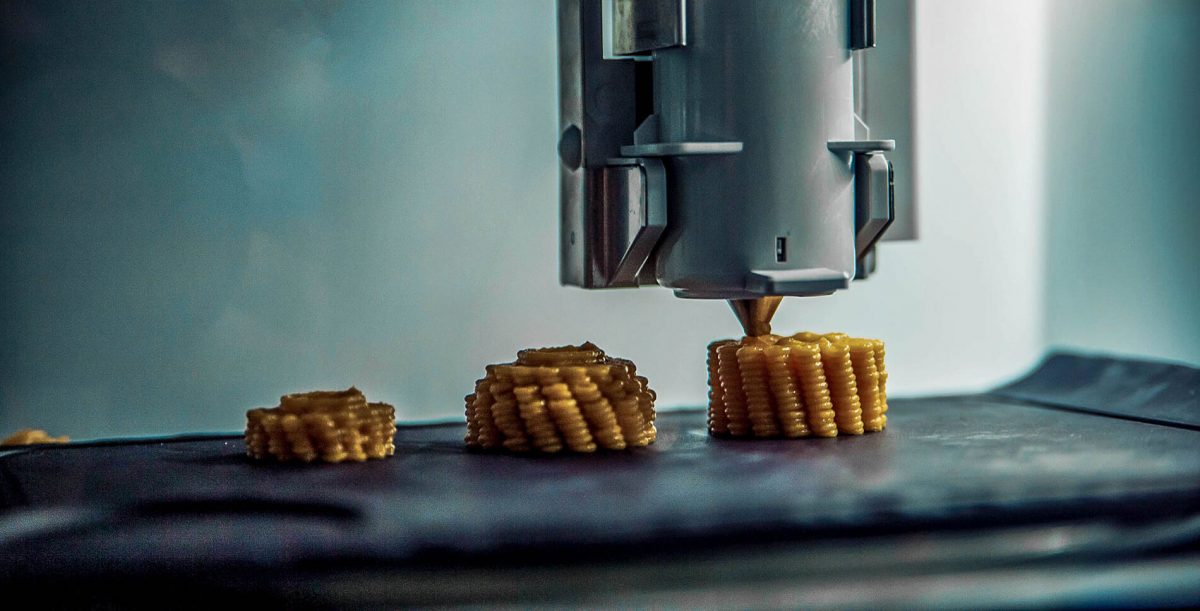How does 3D food printing work?
Exclusive 3D printing restaurants are already a thing , while consumers can buy their own 3D food printers for their home! But, first and foremost, let’s explain what 3D food printing actually means. It is defined as the automated process of manufacturing food products using a variety of additive manufacturing techniques. The most common example of this currently is food grade syringes that hold the printing material, while a food grade nozzle deposits it layer by layer, the so-called extrusion-based printing technique. Additional printing techniques include selective laser sintering, in which powdered food materials are heated and bonded together to form a solid structure and binder jetting, which is similar in nature but uses a liquid binder instead of heat to bond the materials. Sometimes there are post-processes needed such as baking or frying, before the food is safe and ready for consumption.
Which foods can be 3D printed?
Not all foods can be 3D printed of course, at least at this point in time with the currently available technologies. The reason for this is that food materials need to be in paste-like form in order to be able to go into the cartridge, thus limiting the options significantly. Consequently, the types of foods that 3D printing is focused in right now come from inputs of purées, mousses and other sugary ingredients, cheeses, mashes and raw meats. On top of these, some companies are also creating 3D printed pizzas and pasta, or even burgers and sushi.
What are the benefits of 3D printing?
One of the important benefits provided by this process is the ability to cater to people with dietary restrictions, as the ingredients can be handpicked and personalized to each person’s needs and wants. The company Barilla for example, is using 3D printing technology to experiment with gluten-free pasta options. Moreover, 3D printed food can be healthier, as it provides the option of putting a custom amount of protein, sugar, vitamins, and minerals into the foods we consume. In a similar context, 3D printing can assist in reducing food waste by utilizing otherwise “useless” food products like meat off-cuts, distorted vegetables and fruits, sea food by-products and perishables, which can all be turned into a suitable form to be used in printing. For instance, Upprinting Food, a Dutch startup, has already been blending and combining different ingredients from food waste and turning them into materials for 3D printing.
Possible uses for 3D printing in the future?
The precision that can be achieved through this technology could prove to be very beneficial to hospitals for example in the future, where restricted diets may be a necessity. Another field that can benefit greatly from 3D printed food is space travel. The compactness and ease of use, as well as the ability to fulfill all the necessary nutritional requirements of astronauts, make 3D printing the ideal solution to cover the crew’s dietary needs. Lastly, 3D printing can be used to provide a sustainable food source to the world, by assisting in the effort to cover the immense and growing need for food due to the rapid increase of the world’s population.
All in all, 3D printing food is an innovative and exciting technology that has a lot of potential to disrupt industries that span several sectors and might seem totally unrelated at first glance. In reality though, 3D printed food is still in its infancy and needs to see a lot more advancement in its field before seeing a broader adoption from professionals and consumers.
References:
Carolo, L. 3D Printed Food (2021): All You Need to Know. all3dp (2021). Available at: https://all3dp.com/2/3d-printed-food-3d-printing-food/ (Accessed: 08 October 2021).
3dsourced (2021) ‘7 Exciting 3D Printed Food Projects Changing How We Eat Forever’. Available at: https://www.3dsourced.com/guides/3d-printed-food/ (Accessed: 08 October 2021).
Tom, M. 3D Printed Pasta – Are There Limits to the Benefits of 3D Printing in the Food Sector? digital.hbs.edu (2018). Available at: https://digital.hbs.edu/platform-rctom/submission/3d-printed-pasta-are-there-limits-to-the-benefits-of-3d-printing-in-the-food-sector/ (Accessed: 08 October 2021).


Hi! Firstly, great piece about the 3D printed food, it was something completely new to me. It is interesting to read how it works and how it is potentially disruptive. The advantages look promising to the world and could really make a difference I believe! I looked 3D printed food up online to read a bit more about it and discovered a bit more then you are writing here. The negative sides about 3D printed food are not at all mentioned. For example, the lack of mass production, the reduction in jobs of the people who were making the food before it is automated with 3D printers, the restricted build size and design inaccuracies. How can these disadvantages still lead to a disruptive effect for the 3D printers?